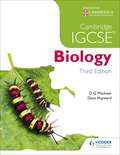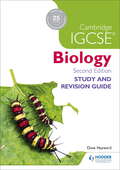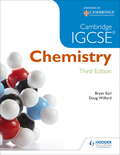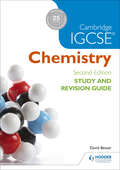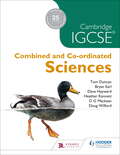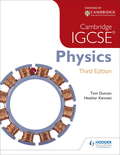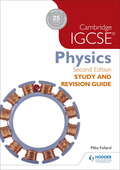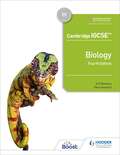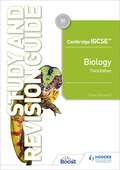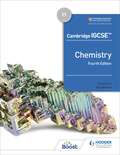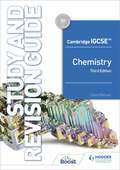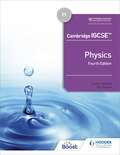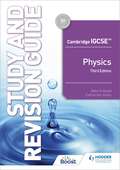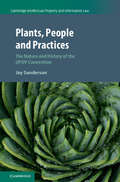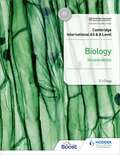- Table View
- List View
Cambridge Classical Studies: Aristotle on Female Animals
by Sophia M. ConnellAristotle's account of female nature has received mostly negative treatment, emphasising what he says females cannot do. Building on recent research, this book comprehensively revises such readings, setting out the complex and positive role played by the female in Aristotle's thought with a particular focus on the longest surviving treatise on reproduction in the ancient corpus, the Generation of Animals. It provides new interpretations of the nature of Aristotle's sexism, his theory of male and female interaction in generation, and his account of inherited features. It also discusses a range of more general issues which can and should be re-examined in light of Aristotle's account of female animals: his methodology, hylomorphism, teleology and psychology. Aristotle on Female Animals will be valuable to all those interested in Aristotle's philosophy and the history of gender.
Cambridge Companions to Philosophy: The Cambridge Companion to Popper
by Jeremy Shearmur Geoffrey StokesKarl Popper was one of the most influential philosophers of the twentieth century. His criticism of induction and his falsifiability criterion of demarcation between science and non-science were major contributions to the philosophy of science. Popper's broader philosophy of critical rationalism comprised a distinctive philosophy of social science and political theory. His critique of historicism and advocacy of the open society marked him out as a significant philosopher of freedom and reason. This book sets out the historical and intellectual contexts in which Popper worked, and offers an overview and diverse criticisms of his central ideas. The volume brings together contributors with expertise on Popper's work, including people personally associated with Popper (such as Jarvie, Miller, Musgrave, Petersen and Shearmur), specialists on the topics treated (Bradie, Godfrey-Smith and Jackson), and scholars with special interests in aspects of Popper's work (Andersson, Hacohen, Maxwell and Stokes).
Cambridge Critical Guides: Aristotle’s Physics
by Mariska LeunissenAristotle's study of the natural world plays a tremendously important part in his philosophical thought. He was very interested in the phenomena of motion, causation, place and time, and teleology, and his theoretical materials in this area are collected in his Physics, a treatise of eight books which has been very influential on later thinkers. This volume of new essays provides cutting-edge research on Aristotle's Physics, taking into account recent changes in the field of Aristotle in terms of its understanding of key concepts and preferred methodology. The contributions reassess the key concepts of the treatise (including nature, chance, teleology, art, and motion), reconstruct Aristotle's methods for the study of nature, and determine the boundaries of his natural philosophy. Because of the foundational nature of Aristotle's Physics itself, the volume will be a must-read for all scholars working on Aristotle.
Cambridge Fundamentals of Neuroscience in Psychology: The Neuroscience of Intelligence
by Richard J. HaierThis book introduces new and provocative neuroscience research that advances our understanding of intelligence and the brain. Compelling evidence shows that genetics plays a more important role than environment as intelligence develops from childhood, and that intelligence test scores correspond strongly to specific features of the brain assessed with neuroimaging. In understandable language, Richard J. Haier explains cutting-edge techniques based on genetics, DNA, and imaging of brain connectivity and function. He dispels common misconceptions, such as the belief that IQ tests are biased or meaningless, and debunks simple interventions alleged to increase intelligence. Readers will learn about the real possibility of dramatically enhancing intelligence based on neuroscience findings and the positive implications this could have for education and social policy. The text also explores potential controversies surrounding neuro-poverty, neuro-socioeconomic status, and the morality of enhancing intelligence for everyone. Online resources, including additional visuals, animations, questions and links, reinforce the material.
Cambridge IGCSE Biology 3rd Edition plus CD
by Dave Hayward D. G. MackeanThe bestselling title, developed by International experts - now updated to offer comprehensive coverage of the core and extended topics in the latest syllabus.- Includes a student's CD-ROM featuring interactive tests and practice for all examination papers- Covers the core and supplement sections of the updated syllabus- Supported by the most comprehensive range of additional material, including Teacher Resources, Laboratory Books, Practice Books and Revision Guides- Written by renowned, expert authors with vast experience of teaching and examining international qualificationsWe are working with Cambridge International Examinations to gain endorsement.
Cambridge IGCSE Biology Study and Revision Guide 2nd edition
by Dave HaywardProviding guidance that helps students practice and troubleshoot their exam technique, these books send them into their exam with the confidence to aim for the best grades.- Enables students to avoid common misconceptions and mistakes by highlighting them throughout- Builds students' skills constructing and writing answers as they progress through a range of practice questions- Allows students to mark their own responses and easily identify areas for improvement using the answers in the back of the book- Helps students target their revision and focus on important concepts and skills with key objectives at the beginning of every chapter- Ensures that students maximise their time in the exam by including examiner's tops and suggestions on how to approach the questionsThis title has not been through the Cambridge International Examinations endorsement process.
Cambridge IGCSE Chemistry 3rd Edition plus CD
by Bryan Earl L.D.R. WifordThe bestselling title, developed by International experts - now updated to offer comprehensive coverage of the core and extended topics in the latest syllabus. - Includes a student's CD-ROM featuring interactive tests and practice for all examination papers - Covers the core and supplement sections of the updated syllabus - Supported by the most comprehensive range of additional material, including Teacher Resources, Laboratory Books, Practice Books and Revision Guides - Written by renowned, expert authors with vast experience of teaching and examining international qualifications We are working with Cambridge International Examinations to gain endorsement.
Cambridge IGCSE Chemistry Study and Revision Guide
by David BesserProviding guidance that helps students practice and troubleshoot their exam technique, these books send them into their exam with the confidence to aim for the best grades.- Enables students to avoid common misconceptions and mistakes by highlighting them throughout- Builds students' skills constructing and writing answers as they progress through a range of practice questions- Allows students to mark their own responses and easily identify areas for improvement using the answers in the back of the book- Helps students target their revision and focus on important concepts and skills with key objectives at the beginning of every chapter- Ensures that students maximise their time in the exam by including examiner's tops and suggestions on how to approach the questionsThis title has not been through the Cambridge International Examinations endorsement process.
Cambridge IGCSE Combined and Co-ordinated Sciences
by Doug Wilford Dave Hayward D. G. MackeanMake best use of your department's specialist skills with this all-in-one textbook from Hodder Education, designed and organized by an experienced Combined and Coordinated Science syllabus teacher. Providing full coverage for the Cambridge IGCSE Combined and Coordinated Science (0653 and 0654) syllabuses, this single textbook approach makes classroom teaching easier by covering the syllabus content for the three Sciences together in one place. It facilitates a coordinated teaching approach across separate classes, with content organized in line with the syllabus for subject specialists, and provides easy and cost-effective transitioning for students moving from a combined course to a coordinated one where they show clear improvement during their course. - Make classroom teaching easier with a single textbook covering the syllabus content for the three Sciences- Use one textbook across separate classes, with content organized in line with the syllabus for subject specialists- Easy and cost-effective transitioning for students moving between the two levels, with all content covered in one place
Cambridge IGCSE Physics 3rd Edition plus CD
by Tom Duncan Heather KennettThe bestselling title, developed by International experts - now updated to offer comprehensive coverage of the core and extended topics in the latest syllabus. - Includes a student's CD-ROM featuring interactive tests and practice for all examination papers - Covers the core and supplement sections of the updated syllabus - Supported by the most comprehensive range of additional material, including Teacher Resources, Laboratory Books, Practice Books and Revision Guides - Written by renowned, expert authors with vast experience of teaching and examining international qualifications We are working with Cambridge International Examinations to gain endorsement.
Cambridge IGCSE Physics Study and Revision Guide 2nd edition
by Mike FollandProviding guidance that helps students practice and troubleshoot their exam technique, these books send them into their exam with the confidence to aim for the best grades.- Enables students to avoid common misconceptions and mistakes by highlighting them throughout- Builds students' skills constructing and writing answers as they progress through a range of practice questions- Allows students to mark their own responses and easily identify areas for improvement using the answers in the back of the book- Helps students target their revision and focus on important concepts and skills with key objectives at the beginning of every chapter- Ensures that students maximise their time in the exam by including examiner's tops and suggestions on how to approach the questionsThis title has not been through the Cambridge International Examinations endorsement process.
Cambridge IGCSE™ Biology 4th Edition
by Dave Hayward D. G. MackeanThis title is endorsed by Cambridge Assessment International Education to support the full syllabus for examination from 2023.Written by renowned expert authors, our updated resources enable the learner to effectively navigate through the content of the updated Cambridge IGCSE™ Biology (0610/0970) syllabus for examination from 2023.- Develop strong practical skills: practical skills features provide guidance on key experiments, interpreting experimental data, and evaluating results; supported by practical questions for practical examinations or alternatives.- Build mathematical skills: worked examples demonstrate the key mathematical skills in scientific contexts; supported by follow-up questions to put these skills into practice.- Consolidate skills and check understanding: self-assessment questions covering core and supplement exam-style questions and checklists embedded throughout the book, alongside key definitions of technical terms and a glossary.- Navigate the syllabus confidently: core and supplement subject content flagged clearly with introductions to each topic outlining the learning objectives and context. - Deepen and enhance scientific knowledge: going further boxes throughout encourage students to take learning to the next level.
Cambridge IGCSE™ Biology 4th Edition
by Dave Hayward D. G. MackeanThis title is endorsed by Cambridge Assessment International Education to support the full syllabus for examination from 2023.Written by renowned expert authors, our updated resources enable the learner to effectively navigate through the content of the updated Cambridge IGCSE™ Biology (0610/0970) syllabus for examination from 2023.- Develop strong practical skills: practical skills features provide guidance on key experiments, interpreting experimental data, and evaluating results; supported by practical questions for practical examinations or alternatives.- Build mathematical skills: worked examples demonstrate the key mathematical skills in scientific contexts; supported by follow-up questions to put these skills into practice.- Consolidate skills and check understanding: self-assessment questions covering core and supplement exam-style questions and checklists embedded throughout the book, alongside key definitions of technical terms and a glossary.- Navigate the syllabus confidently: core and supplement subject content flagged clearly with introductions to each topic outlining the learning objectives and context. - Deepen and enhance scientific knowledge: going further boxes throughout encourage students to take learning to the next level.
Cambridge IGCSE™ Biology Study and Revision Guide Third Edition
by Dave HaywardStretch yourself to achieve the highest grades, with structured syllabus coverage, varied exam-style questions and annotated sample answers, to help you to build the essential skill set for exam success.- Benefit from expert advice and tips on skills and knowledge from experienced subject authors- Target revision and focus on important concepts and skills with key objectives at the beginning of every chapter- Keep track of your own progress with a handy revision planner- Consolidate and apply your understanding of key content with revision activities, short 'Test yourself' and exam-style questions- Apply your understanding of essential practical and mathematical skills with Skills boxes including worked examples
Cambridge IGCSE™ Biology Study and Revision Guide Third Edition
by Dave HaywardStretch yourself to achieve the highest grades, with structured syllabus coverage, varied exam-style questions and annotated sample answers, to help you to build the essential skill set for exam success.- Benefit from expert advice and tips on skills and knowledge from experienced subject authors- Target revision and focus on important concepts and skills with key objectives at the beginning of every chapter- Keep track of your own progress with a handy revision planner- Consolidate and apply your understanding of key content with revision activities, short 'Test yourself' and exam-style questions- Apply your understanding of essential practical and mathematical skills with Skills boxes including worked examples
Cambridge IGCSE™ Chemistry 4th Edition
by Bryan Earl Doug WilfordThis title is endorsed by Cambridge Assessment International Education to support the full syllabus for examination from 2023.Written by renowned expert authors, our updated resources enable the learner to effectively navigate through the content of the updated Cambridge IGCSE™ Chemistry (0620/0971) syllabus for examination from 2023.- Develop strong practical skills: practical skills features provide guidance on key experiments, interpreting experimental data, and evaluating results; supported by practical questions for practical examinations or alternatives.- Build mathematical skills: worked examples demonstrate the key mathematical skills in scientific contexts; supported by follow-up questions to put these skills into practice.- Consolidate skills and check understanding: self-assessment questions covering core and supplement exam-style questions and checklists embedded throughout the book, alongside key definitions of technical terms and a glossary.- Navigate the syllabus confidently: core and supplement subject content flagged clearly with introductions to each topic outlining the learning objectives and context. - Deepen and enhance scientific knowledge: going further boxes throughout encourage students to take learning to the next level.
Cambridge IGCSE™ Chemistry 4th Edition
by Bryan Earl Doug WilfordThis title is endorsed by Cambridge Assessment International Education to support the full syllabus for examination from 2023.Written by renowned expert authors, our updated resources enable the learner to effectively navigate through the content of the updated Cambridge IGCSE™ Chemistry (0620/0971) syllabus for examination from 2023.- Develop strong practical skills: practical skills features provide guidance on key experiments, interpreting experimental data, and evaluating results; supported by practical questions for practical examinations or alternatives.- Build mathematical skills: worked examples demonstrate the key mathematical skills in scientific contexts; supported by follow-up questions to put these skills into practice.- Consolidate skills and check understanding: self-assessment questions covering core and supplement exam-style questions and checklists embedded throughout the book, alongside key definitions of technical terms and a glossary.- Navigate the syllabus confidently: core and supplement subject content flagged clearly with introductions to each topic outlining the learning objectives and context. - Deepen and enhance scientific knowledge: going further boxes throughout encourage students to take learning to the next level.
Cambridge IGCSE™ Chemistry Study and Revision Guide Third Edition
by David BesserStretch yourself to achieve the highest grades, with structured syllabus coverage, varied exam-style questions and annotated sample answers, to help you to build the essential skill set for exam success.- Benefit from expert advice and tips on skills and knowledge from experienced subject authors- Target revision and focus on important concepts and skills with key objectives at the beginning of every chapter- Keep track of your own progress with a handy revision planner- Consolidate and apply your understanding of key content with revision activities, short 'Test yourself' and exam-style questions- Apply your understanding of essential practical and mathematical skills with Skills boxes including worked examples
Cambridge IGCSE™ Chemistry Study and Revision Guide Third Edition
by David BesserStretch yourself to achieve the highest grades, with structured syllabus coverage, varied exam-style questions and annotated sample answers, to help you to build the essential skill set for exam success.- Benefit from expert advice and tips on skills and knowledge from experienced subject authors- Target revision and focus on important concepts and skills with key objectives at the beginning of every chapter- Keep track of your own progress with a handy revision planner- Consolidate and apply your understanding of key content with revision activities, short 'Test yourself' and exam-style questions- Apply your understanding of essential practical and mathematical skills with Skills boxes including worked examples
Cambridge IGCSE™ Physics 4th edition
by Tom Duncan Heather KennettThis title is endorsed by Cambridge Assessment International Education to support the full syllabus for examination from 2023.Written by renowned expert authors, our updated resources enable the learner to effectively navigate through the content of the updated Cambridge IGCSE™ Physics (0625/0972) syllabus for examination from 2023.- Develop strong practical skills: practical skills features provide guidance on key experiments, interpreting experimental data, and evaluating results; supported by practical questions for practical examinations or alternatives.- Build mathematical skills: worked examples demonstrate the key mathematical skills in scientific contexts; supported by follow-up questions to put these skills into practice.- Consolidate skills and check understanding:self-assessment questions covering core and supplement exam-style questions and checklists embedded throughout the book, alongside key definitions of technical terms and a glossary.- Navigate the syllabus confidently: core and supplement subject content flagged clearly with introductions to each topic outlining the learning objectives and context. - Deepen and enhance scientific knowledge: going further boxes throughout encourage students to take learning to the next level.
Cambridge IGCSE™ Physics 4th edition
by Tom Duncan Heather KennettThis title is endorsed by Cambridge Assessment International Education to support the full syllabus for examination from 2023.Written by renowned expert authors, our updated resources enable the learner to effectively navigate through the content of the updated Cambridge IGCSE™ Physics (0625/0972) syllabus for examination from 2023.- Develop strong practical skills: practical skills features provide guidance on key experiments, interpreting experimental data, and evaluating results; supported by practical questions for practical examinations or alternatives.- Build mathematical skills: worked examples demonstrate the key mathematical skills in scientific contexts; supported by follow-up questions to put these skills into practice.- Consolidate skills and check understanding:self-assessment questions covering core and supplement exam-style questions and checklists embedded throughout the book, alongside key definitions of technical terms and a glossary.- Navigate the syllabus confidently: core and supplement subject content flagged clearly with introductions to each topic outlining the learning objectives and context. - Deepen and enhance scientific knowledge: going further boxes throughout encourage students to take learning to the next level.
Cambridge IGCSE™ Physics Study and Revision Guide Third Edition
by Catherine Jones Mike FollandStretch yourself to achieve the highest grades, with structured syllabus coverage, varied exam-style questions and annotated sample answers, to help you to build the essential skill set for exam success.- Benefit from expert advice and tips on skills and knowledge from experienced subject authors- Target revision and focus on important concepts and skills with key objectives at the beginning of every chapter- Keep track of your own progress with a handy revision planner- Consolidate and apply your understanding of key content with revision activities, short 'Test yourself' and exam-style questions- Apply your understanding of essential practical and mathematical skills with Skills boxes including worked examples
Cambridge IGCSE™ Physics Study and Revision Guide Third Edition
by Catherine Jones Mike FollandStretch yourself to achieve the highest grades, with structured syllabus coverage, varied exam-style questions and annotated sample answers, to help you to build the essential skill set for exam success.- Benefit from expert advice and tips on skills and knowledge from experienced subject authors- Target revision and focus on important concepts and skills with key objectives at the beginning of every chapter- Keep track of your own progress with a handy revision planner- Consolidate and apply your understanding of key content with revision activities, short 'Test yourself' and exam-style questions- Apply your understanding of essential practical and mathematical skills with Skills boxes including worked examples
Cambridge Intellectual Property and Information Law: Plants, People and Practices
by Jay SandersonThe International Union for the Protection of New Varieties of Plants (UPOV) and the UPOV Convention are increasingly relevant and important. They have technical, social and normative legitimacy and have standardised numerous concepts and practices related to plant varieties and plant breeding. In this book, Jay Sanderson provides the first sustained and detailed account of the Convention. Building upon the idea that it has an open-ended and contingent relationship with scientific, legal, technical, political, social and institutional actors, the author explores the Convention's history, concepts and practices. Part I examines the emergence of the UPOV Convention during the 1950s and its expanding legitimacy in relation to plant variety protection. Part II explores the Convention's key concepts and practices, including plant breeder, plant variety, plant names (denomination), characteristics, protected material, essentially derived varieties (EDV) and farm saved seed (FSS). This book is an invaluable resource for academics, policy makers, agricultural managers and researchers in this field.
Cambridge International AS & A Level Biology Student's Book 2nd edition
by C. J. CleggThis title is endorsed by Cambridge Assessment International Education to support the full syllabus for examination from 2022.Confidently navigate the updated Cambridge International AS & A Level Biology (9700) syllabus with a structured approach ensuring that the link between theory and practice is consolidated, scientific skills are applied, and analytical skills developed.- Enable students to monitor and build progress with short 'self-assessment' questions throughout the student text, with answers at the back of the book, so students can check their understanding as they work their way through the chapters.- Build scientific communication skills and vocabulary in written responses with a variety of exam-style questions. - Encourage understanding of historical context and scientific applications with extension boxes in the student text.- Have confidence that lessons cover the syllabus completely with a free Scheme of Work available online.- Provide additional practice with the accompanying write-in Practical Skills Workbooks, which once completed, can also be used to recap learning for revision. Also available in the series:Chemistry Student Book 9781510480230 Physics Student Book 9781510482807 Biology Student eTextbook 9781510482913 Biology Whiteboard eTextbook 9781510482920 Chemistry Student eTextbook 9781510482999Chemistry Whiteboard eTextbook 9781510483002 Physics Student eTextbook 9781510483118 Physics Whiteboard eTextbook 9781510483125 Biology Skills Workbook 9781510482869Chemistry Skills Workbook 9781510482852Physics Skills Workbook 9781510482845

